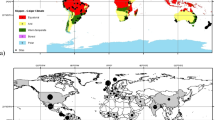Summary
A replicated factorial experiment was designed to test the hypothesis that manipulating inputs of water and mineral nitrogen to a semiarid grassland would disrupt existing interactions resulting in alteration of the structure of the primary producer community. Alteration of community structure was measured as either changes in growing season average biomass of 6 functional groups of plants or their relative contribution to total biomass.
Additions of water greatly increased total biomass and resulted in the replacement of one of the dominant functional groups by a subordinate group. The water plus nitrogen treatment resulted in large biomass increases in two of the dominant functional groups, elimination of succulents as an important component of community structure, and establishment of several introduced weedy species. Continuation of the experiment will likely result in complete dominance of the water plus nitrogen treatment by these introduced species.
Despite the large changes in community structure observed as a result of water- and nitrogen-induced stresses we conclude that the shortgrass prairie in northcentral Colorado is asymptotically stable with respect to these influences.
Similar content being viewed by others
References
Barrett, G.W.: The effects of an acute insecticide stress on a semi-enclosed grassland ecosystem. Ecology 49, 1019–1035 (1968)
Barrett, G.W., Van Dyne, G.M., Odum, E.P.: Stress ecology. BioScience 26 192–194 (1976)
Bartos D.L., Sims, P.L.: Root dymanics of a shortgrass ecosystem. J. Range Manage. 27, 33–36 (1974)
Black, C.C.: Ecological implications of dividing plants into groups with distinct photosynthetic production capacities. Adv. Ecol. Res. 7, 87–109 (1971)
Bulan, C.A., Barrett, G.W.: The effects of two acute stresses on the arthropod component of an experimental grassland ecosystem. Ecology 52, 597–605 (1971)
Cook, C.W.: Insects and waether as they influence growth of cactus on the central Great Plains. Ecology 23, 209–214 (1942)
Dodd, J.L., Lauenroth, W.K.: Response of Opuntia polyacantha to water and nitrogen perturbations in the shortgrass prairie. In: Prairie: A multiple view (M.K. Wali, ed.), pp. 229–240. Grand Forks: University of North Dakota Press 1975
Downton, W.J.S.: The occurrence of C4 photosynthesis among plants. Photosynthetica 9, 96–105 (1975)
Esch, G.W., Gibbons, J.W., Bourgue, J.E.: An analysis of the relationship between stress and parasitism. Am. Midl. Nat. 93, 339–353 (1975)
Fraley, L., Jr.: Response of shortgrass plains vegetation to chronic and seasonally administered gamma radiation. Ph.D. Thesis, Colorado State Univ., Ford Collins, 170 pp. (1971)
Houston, W.R.: Plains pricklypear, weather, and grazing in the northern Great Plains. Ecology 44, 569–574 (1963)
Hurd, L.E., Wolf, L.L.: Stability in relation to nutrient enrichment in arthropod consumers of old-field successional ecosystems. Ecol. Monogr. 44, 465–482 (1974)
Hyder, D.N., Bement, R.E., Remmenga, E.E., Hervey, D.F.: Ecological response of native plants and guidelines for management of shortgrass range. USDA Agric. Res. Serv. Tech. Bull. No. 1503, 87 pp. (1975)
Klipple, G.E., Costello, D.F.: Vegetation and cattle responses to different intensities of grazing on short-grass ranges on the central Great Plains. USDA Tech. Bull. 1216, 82 pp. (1960)
Lauenroth, W.K.: Effects of water and nitrogen stresses on a shortgrass prairie ecosystem. Ph.D. Thesis, Colorado State Univ., Fort Collins, 115 pp. (1973)
Levitt, J.: Responses of plants to environmental stresses, 697 pp. New York: Academic Press (1972)
Lewontin, R.C.: The meaning of stability. In: Diversity and stability in ecological systems. Brookhaven Symposium in Biology (Springfield, Va.), No. 22, pp. 13–24. Washington, D.C.: National Bureau of Standards, U.S. Dept. Commerce 1969
Malone, C.R.: Effects of diazinon contamination on an old-field ecosystem. Am. Midl. Nat. 82, 1–27 (1969)
McNaughton, S.J., Wolf, L.L.: Dominance and the niche in ecological systems. Science 167, 131–139 (1970)
Odum, E.P.: The strategy of ecosystem development. Science 164, 262–270 (1969)
Selye, H.: The stress of life. New York: McGraw-Hill 1956
Williams, G.J. III, Markley, J.L.: The photosynthetic pathway type of North American shortgrass prairie species and some ecological implications. Photosynthetica 7, 262–270 (1973)
Woodwell, G.M.: Effects of pollution on the structure and physiology of ecosystems. Science 168, 429–433 (1970)
Author information
Authors and Affiliations
Rights and permissions
About this article
Cite this article
Lauenroth, W.K., Dodd, J.L. & Sims, P.L. The effects of water- and nitrogen-induced stresses on plant community structure in a semiarid grassland. Oecologia 36, 211–222 (1978). https://doi.org/10.1007/BF00349810
Received:
Issue Date:
DOI: https://doi.org/10.1007/BF00349810




